
 |
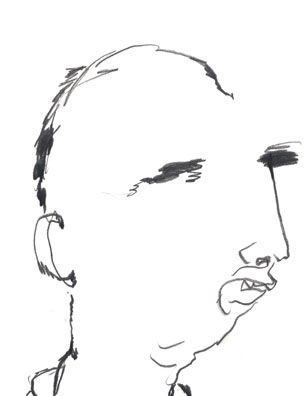
graphite on paper
Critical mass attained? The NYTimes has a story about the international sticker phenomenon appearing on the lightpost near you. Coincidentally, tinsquo.com's new business stickers have just arrived. If you like 'em, you're free to stick 'em - anywhere that might expand the awareness of artblogging, that is. E-mail me and I'll send you as many as a first class stamp can handle.
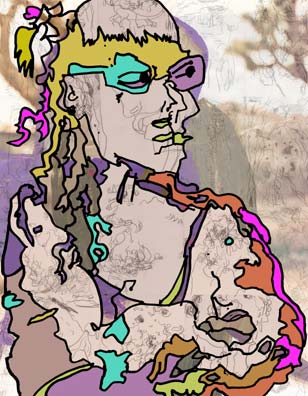
As the first Fall chill sweeps Manhattan, I'm still basking in the glow of our cursory survey of L.A.'s gallery scene. We were surprised by the warm receptions we received even in the midst of late August's art-scene-on-vacation atmosphere. There was good work and no shortage of kind assistance in negotiating the far flung gallery enclaves. Thanks to all those who were so generous with their time and knowledge.
Culver City has good work in focused spaces ensconced in stucco and aluminum siding. Blum and Poe's exhibition of Florian Maier-Aichen's subtly and digitally modified landscape photos were the highlight there. But Liz Oliveria's grad student show of lcd shadow boxes and photos, hidden in her delivery-side garage space off S. LaCienega, bore a charge echoing their industrial digs and revealed forthcoming promise.
Anna Helwing's summer group show offered several funky paintings by Lauren Lavitt whose unprescribed paint handling shifts focus of intent from inch to inch across the painting's surface as a means of holding everything together. Very satisfying. Her's seems like a joyful endeavor.
Then, there's the active transformation of Chinatown's Chung King Road into a two block bazaar of galleries - another example of art's capacity to find and utilize under-appreciated environmental niches. As a pedestrian New Yorker, it was right up my alley...(uh, hello, is this mic on?).
Many of the Chinatown galleries were on hiatus for the month. So, I don't presume to make an authoritative declaration on the matter - still, Black Dragon Society, China Art Objects and Peres Projects stand as particularly gratifying enterprises.
Our big event was a tattoo-packed, rollicking opening for Coop at Six Space. Six Space is the gleaming product of Chicago transplants Caryn Coleman and Sean Bonner, who also operate the website, art.blogging.la - a valuable resource for keeping apprised of the LA gallery scene.
Though they came highly recommended, timing and unaccountable vagaries precluded visits to Susanne Vielmetter, White Room and New Image Art (caps off to them for their recent NeckFace show - glad his work is now visible on both sides of the wall). Nonetheless, these and all the galleries above are now included in the gallery links page.
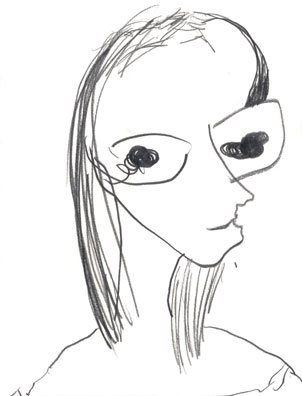
graphite on paper
R.I.P. On Saturday, legendary photojournalist Eddie Adams passed away. In a prolific career, he is most remembered for the famous 1968 photo capturing the precise moment a South Vietnamese Brigadier General fired a bullet into the head of a Vietcong prisoner from an arm's length away on a Saigon street. The image became an instant flash point and persists to this day as an icon of the brutality of the Vietnam War.
Roebling Hall recently had an exhibition of Moises Saman’s photographs. For an icon of our current conflict I’d nominate this image of his. Reading as a picture of transcendent ganglia, the photo suggests that the tendrils of connection that unite us in community can also be subverted into conduits of violence.
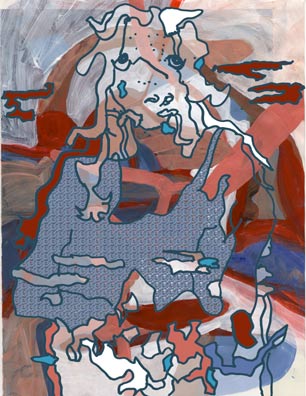
"It was one of the darker tunnels in Canada."
This vexing gem of an insight is a toss-away line proffered in Tom McCarthy's 2003 film, The Station Agent. Starring Peter Dinklage, Patricia Clarkson and Bobby Cannavale, the film is a measured jewel that I happened to run across this week.
Never a "spoiler," I did have one idiosyncratic reaction to the film (to which, my girlfriend was quick to quip, "Only a painter..."): Through much of the movie, I kept getting flashes of Giacometti, not so much the look of his sculptures, but the psychic feel they engender - the loneliness. (For those who've seen it, or will soon, I acknowledge the unintended irony in conflating the main character with the work of Giacometti).
Traditional readings of Giacometti's signature sculptures see his figures existing in a state of isolation, anxiety and unbridgeable individuation. Thus, it is fitting and ironic that Giacometti's work has an increasing power to lure people together. Throughout the 2001 MOMA Retrospective, his sculptures were often surrounded by standing room only crowds - people, ostensibly, gathered to collectively contemplate loneliness.
I've noticed the same dynamic drawing crowds at many recent films (The Hours, Igby Goes Down, Rushmore, Lost In Translation, Punch Drunk Love to name only a few). It would seem within our singularity resides our commonality. The Station Agent arrives at a similar conclusion, adding fraternal flesh to Giacometti's talismanic masterpieces.
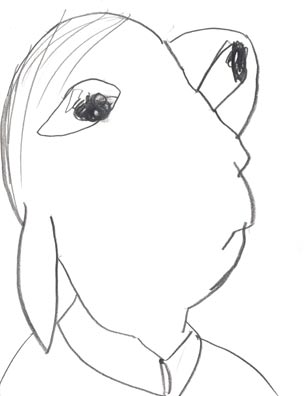
graphite on paper
The answers to all your questions await. At long last, TINSQUO has an About page!
 |
 |
 |
 |
 |
 |
 |
 |
 |
Today's post is the final group of photographs from my recent trip to Southern California -
While traveling, I picked up Christopher Ricks' new book "Dylan's Visions of Sin." Ricks is the newly elected Oxford Professor of Poetry. He has a shelf worth of books to his credit including analyses of the works of Milton, Keats, Tennyson, Beckett and T.S. Eliot. Here, he accords Bob Dylan's lyrics the kind of respect and investigation given those earlier masters.
It is a thrilling read and a great traveling companion.
My return from California shortly preceded the Republican convention here in New York. While the GOP was meeting inside Madison Square Garden, it was apparent that there was another convention, often described as a "protest," taking place outside in the streets and parks. I would imagine this dynamic, though I can't speak from firsthand experience, bore similarities to the times of the 1960's when Dylan's cultural impact was at its apex.
How does an artist function in a polarized atmosphere?
In "Desolation Row," Dylan slyly references the title of a traditional folk song, singing:
And everybody's shouting
"Which Side Are You On?"
From page 30 of "Dylan's Visions of Sin," Christopher Ricks:
Dylan didn't like to bad-mouth a song that was in a good cause. But he knew, even back then in 1963, that this "two sides" business was averting its eyes and its ears from too much. So before long he was hardening his art.
[In a 1966 Playboy interview, Dylan says:] "Songs like 'Which Side Are You On?'...they're not folk-music songs; they're political songs. They're already dead."
[Finally, an exchange found in "Bob Dylan in His Own Words" from December 16, 1965:]
Q: What does the word protest mean to you?
A: To me? Means uh...singing when I don't really wanna sing.Q: What?
A: It means singing against your wishes to sing.Q: Do you sing against your wishes to sing?
A: No, no.Q: Do you sing protest songs?
A: No.Q: What do you sing?
A: I sing love songs.